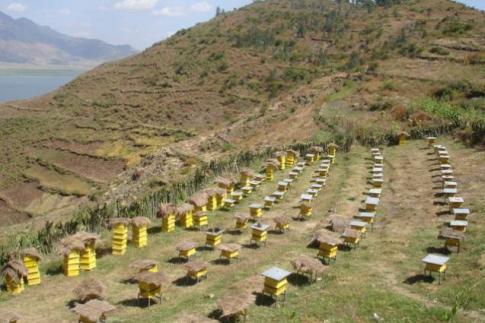The rise and fall of bees

Their brilliant evolutionary strategy isn’t working so well in the modern world...
Their brilliant evolutionary strategy isn’t working so well in the modern world.
BEES are wasps that went vegetarian. This was a brilliant evolutionary move: they now outnumber wasps by around three to one. Instead of hunting creatures that would rather not be eaten, they turned to living things that offered themselves on a plate. Bees and flowers evolved together in a gorgeous spiral of mutual dependence. Nectar and pollen feed the bees; in return, the plants get to procreate.
Humans are beneficiaries, too. These days honey is seen as a minor treat, but for hunter-gatherers it was essential: members of the Hadza, a tribe in Tanzania, get as much as 15% of their calories from honey, not including nutrition from the larvae and pollen they also consume. Of all the foods in nature, honey is the richest in energy. “The need to feed our big, hungry brains may help explain why we crave it,” Thor Hanson explains in “Buzz”, a book of popular science at its intelligent best.
The 20,000 species of wild bees are even more important than the domesticated kind, through their role in pollinating crops. That is why the problems afflicting both domestic and wild bees represent a danger for people, too.
A decade ago, stories of “colony collapse disorder” and crashing bee populations led to predictions of imminent ecological disaster. When the “beepocalypse” failed to materialise, humanity lost interest, but the insects’ problems persist. Mr Hanson cites an authoritative survey showing that around 40% of bee species globally are in decline or threatened with extinction. Beekeepers in North America and Europe are losing hives at an abnormally high rate.
Why? Diana Cox-Foster, an entomologist, offers Mr Hanson the theory of the four Ps: parasites, poor nutrition, pesticides and pathogens. Widespread culling of flowers is a particular problem. “People look across a park or a golf course and think it’s green and lush, but to a bee it’s like a desert or a petrified forest—there’s nothing to survive on,” she says.
The remedies are clear, according to Mr Hanson: “providing landscapes with more flowers and nesting habitat, reducing pesticide use, and stopping the long-distance movement of domestic bees (and the pathogens that travel with them).” Fewer bees will mean fewer plants and therefore less to eat and less oxygen to breathe. Time to take their problems seriously.
* * *
Ever wondered where all the food that you eat comes from? Well, it might surprise you that a significant proportion is provided by bees one way or another.
If you look at the plate of food on your dinner table, bees have played their part either pollinating the many vegetables and fruits we eat directly, or pollinating the food for the animals that we then consume. And that’s not all bees do for us - honey and wax are two other important products that come courtesy of bees.
But honey bees are disappearing globally at an alarming rate due to pesticides, parasites, disease and habitat loss. If these little insects that help provide so much of the food we eat were to vanish, what would we do without them?
What bees do for usAn illustration of what all honey bees, and a colony of honey bees, do for us in the UK each year.
An illustration of what all honey bees, and a colony of honey bees, do for us in the UK each year. However, pollination is from all invertebrates, of which honey bees are a significant contributor.
Pollination and food production
Watch Alan Titchmarsh explain the importance of bumblebees in pollinating crops on an industrial scale. [Archive clip from the BBC Two series, 'Nature of Britain', first broadcast in 2007.]
Pollination is the vital process in flowering plant reproduction involving the transfer of pollen grains from the anther (or male part) to the stigma (or female part) of the same, or another plant of the same species. The fertilised egg cells grow into seeds which are then spread in the many fruits and vegetables that we all love to eat.
This transfer of pollen can be done by the wind, birds, bats, mammals and of course insects; one of the most important of these are the honey bees that pollinate on a huge commercial scale. All sorts of fruit and vegetables are pollinated by honey bees, such as broccoli and squash, apples and almonds.
Pollination is not just important for the food we eat directly, it’s vital for the foraging crops, such as field beans and clover, used to feed the livestock we depend on for meat. Just as importantly, it helps to feed many other animals in the food chain and maintains the genetic diversity of the flowering plants.
The perfect pollinator
Wing
Body
Eye
Antenna
Mouthparts
Pollen basket
The threats to honey bees
There is no doubt that honey bee populations are in trouble as Chris Packham explains in more detail below.
Can bees be replaced?
In a world without honey bees which of these could take over the pollinating role.




 del.icio.us
del.icio.us Digg
Digg

Post your comment